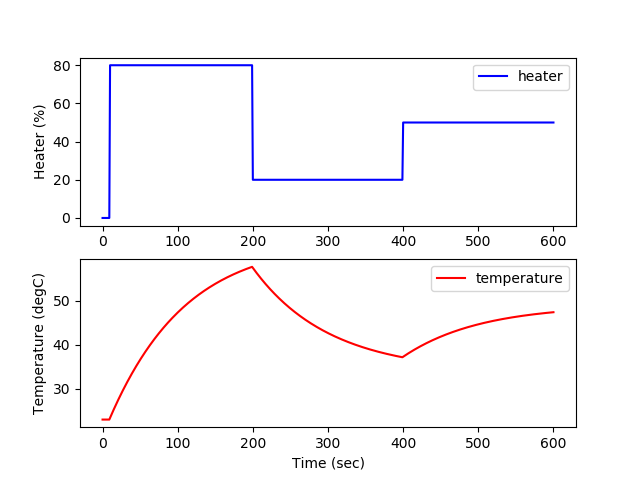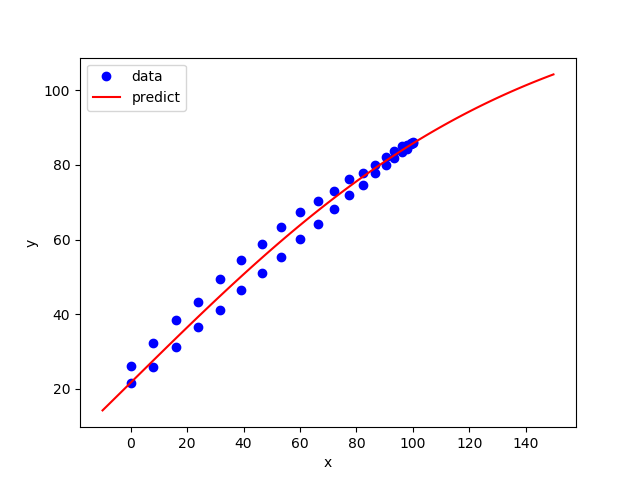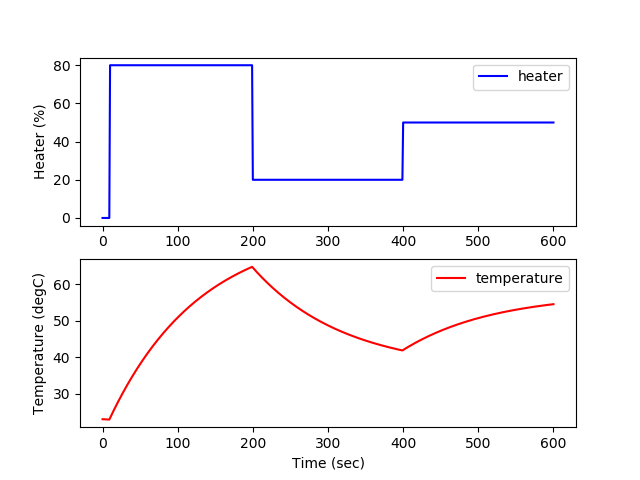TCLab A - SISO Digital Twin
The TCLab is a hands-on application of machine learning and advanced temperature control with two heaters and two temperature sensors. The labs reinforce principles of model development, estimation, and advanced control methods. This is the first exercise to simulate an energy balance and compare the predictions to deep learning with a multi-layered neural network.
Lab Problem Statement
Data and Solutions
- SISO Energy Balance Solution with MATLAB and Python
- Steady state data, 1 heater
- Dynamic data, 1 heater
import numpy as np
import pandas as pd
import tclab
import time
import matplotlib.pyplot as plt
# generate step test data on Arduino
filename = 'tclab_dyn_data1.csv'
# heater steps
Qd = np.zeros(601)
Qd[10:200] = 80
Qd[200:400] = 20
Qd[400:] = 50
# Connect to Arduino
a = tclab.TCLab()
fid = open(filename,'w')
fid.write('Time,H1,T1\n')
fid.close()
# run step test (10 min)
for i in range(601):
# set heater value
a.Q1(Qd[i])
print('Time: ' + str(i) + \
' H1: ' + str(Qd[i]) + \
' T1: ' + str(a.T1))
# wait 1 second
time.sleep(1)
# write results to file
fid = open(filename,'a')
fid.write(str(i)+','+str(Qd[i])+','+str(a.T1)+'\n')
fid.close()
# close connection to Arduino
a.close()
# read data file
data = pd.read_csv(filename)
# plot measurements
plt.figure()
plt.subplot(2,1,1)
plt.plot(data['Time'],data['H1'],'b-',label='Heater 1')
plt.ylabel('Heater (%)')
plt.legend(loc='best')
plt.subplot(2,1,2)
plt.plot(data['Time'],data['T1'],'r.',label='Temperature 1')
plt.ylabel('Temperature (degC)')
plt.legend(loc='best')
plt.xlabel('Time (sec)')
plt.savefig('tclab_dyn_meas1.png')
plt.show()
import pandas as pd
import tclab
import time
import matplotlib.pyplot as plt
# generate step test data on Arduino
filename = 'tclab_dyn_data1.csv'
# heater steps
Qd = np.zeros(601)
Qd[10:200] = 80
Qd[200:400] = 20
Qd[400:] = 50
# Connect to Arduino
a = tclab.TCLab()
fid = open(filename,'w')
fid.write('Time,H1,T1\n')
fid.close()
# run step test (10 min)
for i in range(601):
# set heater value
a.Q1(Qd[i])
print('Time: ' + str(i) + \
' H1: ' + str(Qd[i]) + \
' T1: ' + str(a.T1))
# wait 1 second
time.sleep(1)
# write results to file
fid = open(filename,'a')
fid.write(str(i)+','+str(Qd[i])+','+str(a.T1)+'\n')
fid.close()
# close connection to Arduino
a.close()
# read data file
data = pd.read_csv(filename)
# plot measurements
plt.figure()
plt.subplot(2,1,1)
plt.plot(data['Time'],data['H1'],'b-',label='Heater 1')
plt.ylabel('Heater (%)')
plt.legend(loc='best')
plt.subplot(2,1,2)
plt.plot(data['Time'],data['T1'],'r.',label='Temperature 1')
plt.ylabel('Temperature (degC)')
plt.legend(loc='best')
plt.xlabel('Time (sec)')
plt.savefig('tclab_dyn_meas1.png')
plt.show()

import numpy as np
import matplotlib.pyplot as plt
from gekko import GEKKO
# initialize GEKKO model
m = GEKKO()
# model discretized time
n = 60*10+1 # Number of second time points (10min)
m.time = np.linspace(0,n-1,n) # Time vector
# Parameters
Qd = np.zeros(601)
Qd[10:200] = 80
Qd[200:400] = 20
Qd[400:] = 50
Q = m.Param(value=Qd) # Percent Heater (0-100%)
T0 = m.Param(value=23.0+273.15) # Initial temperature
Ta = m.Param(value=23.0+273.15) # K
U = m.Param(value=10.0) # W/m^2-K
mass = m.Param(value=4.0/1000.0) # kg
Cp = m.Param(value=0.5*1000.0) # J/kg-K
A = m.Param(value=12.0/100.0**2) # Area in m^2
alpha = m.Param(value=0.01) # W / % heater
eps = m.Param(value=0.9) # Emissivity
sigma = m.Const(5.67e-8) # Stefan-Boltzman
T = m.Var(value=T0) #Temperature state as GEKKO variable
m.Equation(T.dt() == (1.0/(mass*Cp))*(U*A*(Ta-T) \
+ eps * sigma * A * (Ta**4 - T**4) \
+ alpha*Q))
# simulation mode
m.options.IMODE = 4
# simulation model
m.solve()
# plot results
plt.figure(1)
plt.subplot(2,1,1)
plt.plot(m.time,Q.value,'b-',label='heater')
plt.ylabel('Heater (%)')
plt.legend(loc='best')
plt.subplot(2,1,2)
plt.plot(m.time,np.array(T.value)-273.15,'r-',label='temperature')
plt.ylabel('Temperature (degC)')
plt.legend(loc='best')
plt.xlabel('Time (sec)')
plt.savefig('tclab_eb_pred.png')
plt.show()
import matplotlib.pyplot as plt
from gekko import GEKKO
# initialize GEKKO model
m = GEKKO()
# model discretized time
n = 60*10+1 # Number of second time points (10min)
m.time = np.linspace(0,n-1,n) # Time vector
# Parameters
Qd = np.zeros(601)
Qd[10:200] = 80
Qd[200:400] = 20
Qd[400:] = 50
Q = m.Param(value=Qd) # Percent Heater (0-100%)
T0 = m.Param(value=23.0+273.15) # Initial temperature
Ta = m.Param(value=23.0+273.15) # K
U = m.Param(value=10.0) # W/m^2-K
mass = m.Param(value=4.0/1000.0) # kg
Cp = m.Param(value=0.5*1000.0) # J/kg-K
A = m.Param(value=12.0/100.0**2) # Area in m^2
alpha = m.Param(value=0.01) # W / % heater
eps = m.Param(value=0.9) # Emissivity
sigma = m.Const(5.67e-8) # Stefan-Boltzman
T = m.Var(value=T0) #Temperature state as GEKKO variable
m.Equation(T.dt() == (1.0/(mass*Cp))*(U*A*(Ta-T) \
+ eps * sigma * A * (Ta**4 - T**4) \
+ alpha*Q))
# simulation mode
m.options.IMODE = 4
# simulation model
m.solve()
# plot results
plt.figure(1)
plt.subplot(2,1,1)
plt.plot(m.time,Q.value,'b-',label='heater')
plt.ylabel('Heater (%)')
plt.legend(loc='best')
plt.subplot(2,1,2)
plt.plot(m.time,np.array(T.value)-273.15,'r-',label='temperature')
plt.ylabel('Temperature (degC)')
plt.legend(loc='best')
plt.xlabel('Time (sec)')
plt.savefig('tclab_eb_pred.png')
plt.show()


import numpy as np
import pandas as pd
import matplotlib.pyplot as plt
from gekko import GEKKO
import time
# -------------------------------------
# import or generate data
# -------------------------------------
filename = 'tclab_ss_data1.csv'
try:
try:
data = pd.read_csv(filename)
except:
url = 'https://apmonitor.com/do/uploads/Main/tclab_ss_data1.txt'
data = pd.read_csv(url)
except:
# generate training data if data file not available
import tclab
# Connect to Arduino
a = tclab.TCLab()
fid = open(filename,'w')
fid.write('Heater,Temperature\n')
# test takes 2 hours = 40 pts * 3 minutes each
npts = 40
Q = np.sin(np.linspace(0,np.pi,npts))*100
for i in range(npts):
# set heater value
a.Q1(Q[i])
print('Heater 1: ' + str(Q[i]) + ' %')
# wait 3 minutes
time.sleep(3*60)
# record temperature and heater value
print('Temperature 1: ' + str(a.T1) + ' degC')
fid.write(str(Q[i])+','+str(a.T1)+'\n')
# close file
fid.close()
# close connection to Arduino
a.close()
# read data file
data = pd.read_csv(filename)
# -------------------------------------
# scale data
# -------------------------------------
x = data['Heater'].values
y = data['Temperature'].values
# minimum of x,y
x_min = min(x)
y_min = min(y)
# range of x,y
x_range = max(x)-min(x)
y_range = max(y)-min(y)
# scaled data
xs = (x - x_min)/x_range
ys = (y - y_min)/y_range
# -------------------------------------
# build neural network
# -------------------------------------
nin = 1 # inputs
n1 = 1 # hidden layer 1 (linear)
n2 = 1 # hidden layer 2 (nonlinear)
n3 = 1 # hidden layer 3 (linear)
nout = 1 # outputs
# Initialize gekko models
train = GEKKO()
test = GEKKO()
dyn = GEKKO()
model = [train,test,dyn]
for m in model:
# input(s)
m.inpt = m.Param()
# layer 1
m.w1 = m.Array(m.FV, (nin,n1))
m.l1 = [m.Intermediate(m.w1[0,i]*m.inpt) for i in range(n1)]
# layer 2
m.w2 = m.Array(m.FV, (n1,n2))
m.l2 = [m.Intermediate(sum([m.tanh(m.w2[j,i]*m.l1[j]) \
for j in range(n1)])) for i in range(n2)]
# layer 3
m.w3 = m.Array(m.FV, (n2,n3))
m.l3 = [m.Intermediate(sum([m.w3[j,i]*m.l2[j] \
for j in range(n2)])) for i in range(n3)]
# output(s)
m.outpt = m.CV()
m.Equation(m.outpt==sum([m.l3[i] for i in range(n3)]))
# flatten matrices
m.w1 = m.w1.flatten()
m.w2 = m.w2.flatten()
m.w3 = m.w3.flatten()
# -------------------------------------
# fit parameter weights
# -------------------------------------
m = train
m.inpt.value=xs
m.outpt.value=ys
m.outpt.FSTATUS = 1
for i in range(len(m.w1)):
m.w1[i].FSTATUS=1
m.w1[i].STATUS=1
m.w1[i].MEAS=1.0
for i in range(len(m.w2)):
m.w2[i].STATUS=1
m.w2[i].FSTATUS=1
m.w2[i].MEAS=0.5
for i in range(len(m.w3)):
m.w3[i].FSTATUS=1
m.w3[i].STATUS=1
m.w3[i].MEAS=1.0
m.options.IMODE = 2
m.options.SOLVER = 3
m.options.EV_TYPE = 2
m.solve(disp=False)
# -------------------------------------
# test sample points
# -------------------------------------
m = test
for i in range(len(m.w1)):
m.w1[i].MEAS=train.w1[i].NEWVAL
m.w1[i].FSTATUS = 1
print('w1['+str(i)+']: '+str(m.w1[i].MEAS))
for i in range(len(m.w2)):
m.w2[i].MEAS=train.w2[i].NEWVAL
m.w2[i].FSTATUS = 1
print('w2['+str(i)+']: '+str(m.w2[i].MEAS))
for i in range(len(m.w3)):
m.w3[i].MEAS=train.w3[i].NEWVAL
m.w3[i].FSTATUS = 1
print('w3['+str(i)+']: '+str(m.w3[i].MEAS))
m.inpt.value=np.linspace(-0.1,1.5,100)
m.options.IMODE = 2
m.options.SOLVER = 3
m.solve(disp=False)
# -------------------------------------
# un-scale predictions
# -------------------------------------
xp = np.array(test.inpt.value) * x_range + x_min
yp = np.array(test.outpt.value) * y_range + y_min
# -------------------------------------
# plot results
# -------------------------------------
plt.figure()
plt.plot(x,y,'bo',label='data')
plt.plot(xp,yp,'r-',label='predict')
plt.legend(loc='best')
plt.ylabel('y')
plt.xlabel('x')
plt.savefig('tclab_ss_data1.png')
# -------------------------------------
# generate dynamic predictions
# -------------------------------------
m = dyn
m.time = np.linspace(0,600,601)
# load neural network parameters
for i in range(len(m.w1)):
m.w1[i].MEAS=train.w1[i].NEWVAL
m.w1[i].FSTATUS = 1
for i in range(len(m.w2)):
m.w2[i].MEAS=train.w2[i].NEWVAL
m.w2[i].FSTATUS = 1
for i in range(len(m.w3)):
m.w3[i].MEAS=train.w3[i].NEWVAL
m.w3[i].FSTATUS = 1
# doublet test
Qd = np.zeros(601)
Qd[10:200] = 80
Qd[200:400] = 20
Qd[400:] = 50
Q = m.Param()
Q.value = Qd
# scaled input
m.inpt.value = (Qd - x_min) / x_range
# define Temperature output
Q0 = 0 # initial heater
T0 = 23 # initial temperature
# scaled steady state ouput
T_ss = m.Var(value=T0)
m.Equation(T_ss == m.outpt*y_range + y_min)
# dynamic prediction
T = m.Var(value=T0)
# time constant
tau = m.Param(value=120) # determine in a later exercise
# additional model equation for dynamics
m.Equation(tau*T.dt()==-(T-T0)+(T_ss-T0))
# solve dynamic simulation
m.options.IMODE=4
m.solve()
plt.figure()
plt.subplot(2,1,1)
plt.plot(m.time,Q.value,'b-',label='heater')
plt.ylabel('Heater (%)')
plt.legend(loc='best')
plt.subplot(2,1,2)
plt.plot(m.time,T.value,'r-',label='temperature')
#plt.plot(m.time,T_ss.value,'k--',label='target temperature')
plt.ylabel('Temperature (degC)')
plt.legend(loc='best')
plt.xlabel('Time (sec)')
plt.savefig('tclab_dyn_pred.png')
plt.show()
import pandas as pd
import matplotlib.pyplot as plt
from gekko import GEKKO
import time
# -------------------------------------
# import or generate data
# -------------------------------------
filename = 'tclab_ss_data1.csv'
try:
try:
data = pd.read_csv(filename)
except:
url = 'https://apmonitor.com/do/uploads/Main/tclab_ss_data1.txt'
data = pd.read_csv(url)
except:
# generate training data if data file not available
import tclab
# Connect to Arduino
a = tclab.TCLab()
fid = open(filename,'w')
fid.write('Heater,Temperature\n')
# test takes 2 hours = 40 pts * 3 minutes each
npts = 40
Q = np.sin(np.linspace(0,np.pi,npts))*100
for i in range(npts):
# set heater value
a.Q1(Q[i])
print('Heater 1: ' + str(Q[i]) + ' %')
# wait 3 minutes
time.sleep(3*60)
# record temperature and heater value
print('Temperature 1: ' + str(a.T1) + ' degC')
fid.write(str(Q[i])+','+str(a.T1)+'\n')
# close file
fid.close()
# close connection to Arduino
a.close()
# read data file
data = pd.read_csv(filename)
# -------------------------------------
# scale data
# -------------------------------------
x = data['Heater'].values
y = data['Temperature'].values
# minimum of x,y
x_min = min(x)
y_min = min(y)
# range of x,y
x_range = max(x)-min(x)
y_range = max(y)-min(y)
# scaled data
xs = (x - x_min)/x_range
ys = (y - y_min)/y_range
# -------------------------------------
# build neural network
# -------------------------------------
nin = 1 # inputs
n1 = 1 # hidden layer 1 (linear)
n2 = 1 # hidden layer 2 (nonlinear)
n3 = 1 # hidden layer 3 (linear)
nout = 1 # outputs
# Initialize gekko models
train = GEKKO()
test = GEKKO()
dyn = GEKKO()
model = [train,test,dyn]
for m in model:
# input(s)
m.inpt = m.Param()
# layer 1
m.w1 = m.Array(m.FV, (nin,n1))
m.l1 = [m.Intermediate(m.w1[0,i]*m.inpt) for i in range(n1)]
# layer 2
m.w2 = m.Array(m.FV, (n1,n2))
m.l2 = [m.Intermediate(sum([m.tanh(m.w2[j,i]*m.l1[j]) \
for j in range(n1)])) for i in range(n2)]
# layer 3
m.w3 = m.Array(m.FV, (n2,n3))
m.l3 = [m.Intermediate(sum([m.w3[j,i]*m.l2[j] \
for j in range(n2)])) for i in range(n3)]
# output(s)
m.outpt = m.CV()
m.Equation(m.outpt==sum([m.l3[i] for i in range(n3)]))
# flatten matrices
m.w1 = m.w1.flatten()
m.w2 = m.w2.flatten()
m.w3 = m.w3.flatten()
# -------------------------------------
# fit parameter weights
# -------------------------------------
m = train
m.inpt.value=xs
m.outpt.value=ys
m.outpt.FSTATUS = 1
for i in range(len(m.w1)):
m.w1[i].FSTATUS=1
m.w1[i].STATUS=1
m.w1[i].MEAS=1.0
for i in range(len(m.w2)):
m.w2[i].STATUS=1
m.w2[i].FSTATUS=1
m.w2[i].MEAS=0.5
for i in range(len(m.w3)):
m.w3[i].FSTATUS=1
m.w3[i].STATUS=1
m.w3[i].MEAS=1.0
m.options.IMODE = 2
m.options.SOLVER = 3
m.options.EV_TYPE = 2
m.solve(disp=False)
# -------------------------------------
# test sample points
# -------------------------------------
m = test
for i in range(len(m.w1)):
m.w1[i].MEAS=train.w1[i].NEWVAL
m.w1[i].FSTATUS = 1
print('w1['+str(i)+']: '+str(m.w1[i].MEAS))
for i in range(len(m.w2)):
m.w2[i].MEAS=train.w2[i].NEWVAL
m.w2[i].FSTATUS = 1
print('w2['+str(i)+']: '+str(m.w2[i].MEAS))
for i in range(len(m.w3)):
m.w3[i].MEAS=train.w3[i].NEWVAL
m.w3[i].FSTATUS = 1
print('w3['+str(i)+']: '+str(m.w3[i].MEAS))
m.inpt.value=np.linspace(-0.1,1.5,100)
m.options.IMODE = 2
m.options.SOLVER = 3
m.solve(disp=False)
# -------------------------------------
# un-scale predictions
# -------------------------------------
xp = np.array(test.inpt.value) * x_range + x_min
yp = np.array(test.outpt.value) * y_range + y_min
# -------------------------------------
# plot results
# -------------------------------------
plt.figure()
plt.plot(x,y,'bo',label='data')
plt.plot(xp,yp,'r-',label='predict')
plt.legend(loc='best')
plt.ylabel('y')
plt.xlabel('x')
plt.savefig('tclab_ss_data1.png')
# -------------------------------------
# generate dynamic predictions
# -------------------------------------
m = dyn
m.time = np.linspace(0,600,601)
# load neural network parameters
for i in range(len(m.w1)):
m.w1[i].MEAS=train.w1[i].NEWVAL
m.w1[i].FSTATUS = 1
for i in range(len(m.w2)):
m.w2[i].MEAS=train.w2[i].NEWVAL
m.w2[i].FSTATUS = 1
for i in range(len(m.w3)):
m.w3[i].MEAS=train.w3[i].NEWVAL
m.w3[i].FSTATUS = 1
# doublet test
Qd = np.zeros(601)
Qd[10:200] = 80
Qd[200:400] = 20
Qd[400:] = 50
Q = m.Param()
Q.value = Qd
# scaled input
m.inpt.value = (Qd - x_min) / x_range
# define Temperature output
Q0 = 0 # initial heater
T0 = 23 # initial temperature
# scaled steady state ouput
T_ss = m.Var(value=T0)
m.Equation(T_ss == m.outpt*y_range + y_min)
# dynamic prediction
T = m.Var(value=T0)
# time constant
tau = m.Param(value=120) # determine in a later exercise
# additional model equation for dynamics
m.Equation(tau*T.dt()==-(T-T0)+(T_ss-T0))
# solve dynamic simulation
m.options.IMODE=4
m.solve()
plt.figure()
plt.subplot(2,1,1)
plt.plot(m.time,Q.value,'b-',label='heater')
plt.ylabel('Heater (%)')
plt.legend(loc='best')
plt.subplot(2,1,2)
plt.plot(m.time,T.value,'r-',label='temperature')
#plt.plot(m.time,T_ss.value,'k--',label='target temperature')
plt.ylabel('Temperature (degC)')
plt.legend(loc='best')
plt.xlabel('Time (sec)')
plt.savefig('tclab_dyn_pred.png')
plt.show()
# see https://apmonitor.com/wiki/index.php/Apps/ARXTimeSeries
from gekko import GEKKO
import numpy as np
import pandas as pd
import matplotlib.pyplot as plt
# load data and parse into columns
url = 'http://apmonitor.com/do/uploads/Main/tclab_dyn_data2.txt'
data = pd.read_csv(url)
t = data['Time']
u = data['H1']
y = data['T1']
m = GEKKO()
# system identification
na = 2 # output coefficients
nb = 2 # input coefficients
yp,p,K = m.sysid(t,u,y,na,nb,pred='meas')
plt.figure()
plt.subplot(2,1,1)
plt.plot(t,u,label=r'$Heater_1$')
plt.legend()
plt.ylabel('Heater')
plt.subplot(2,1,2)
plt.plot(t,y)
plt.plot(t,yp)
plt.legend([r'$T_{meas}$',r'$T_{pred}$'])
plt.ylabel('Temperature (°C)')
plt.xlabel('Time (sec)')
plt.show()
from gekko import GEKKO
import numpy as np
import pandas as pd
import matplotlib.pyplot as plt
# load data and parse into columns
url = 'http://apmonitor.com/do/uploads/Main/tclab_dyn_data2.txt'
data = pd.read_csv(url)
t = data['Time']
u = data['H1']
y = data['T1']
m = GEKKO()
# system identification
na = 2 # output coefficients
nb = 2 # input coefficients
yp,p,K = m.sysid(t,u,y,na,nb,pred='meas')
plt.figure()
plt.subplot(2,1,1)
plt.plot(t,u,label=r'$Heater_1$')
plt.legend()
plt.ylabel('Heater')
plt.subplot(2,1,2)
plt.plot(t,y)
plt.plot(t,yp)
plt.legend([r'$T_{meas}$',r'$T_{pred}$'])
plt.ylabel('Temperature (°C)')
plt.xlabel('Time (sec)')
plt.show()
See also: